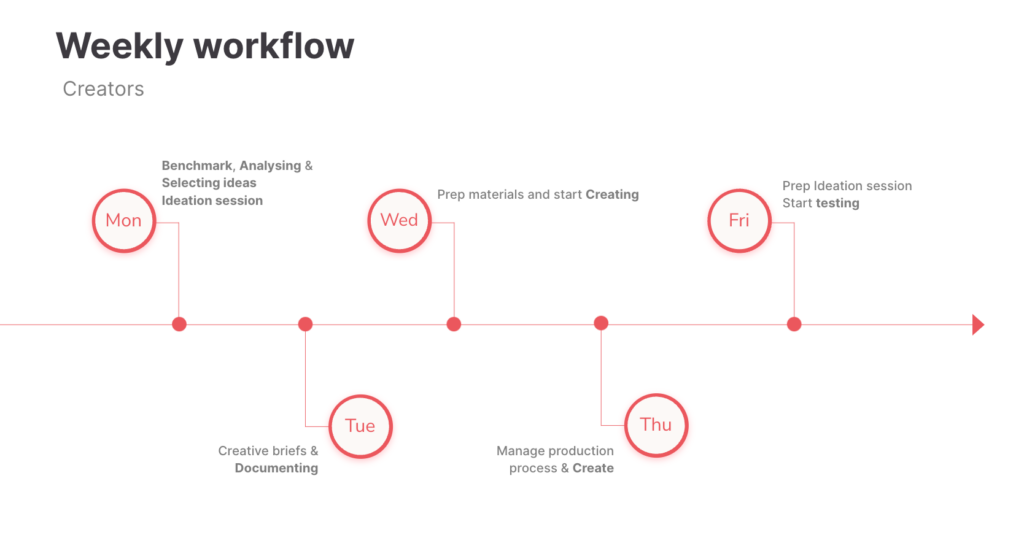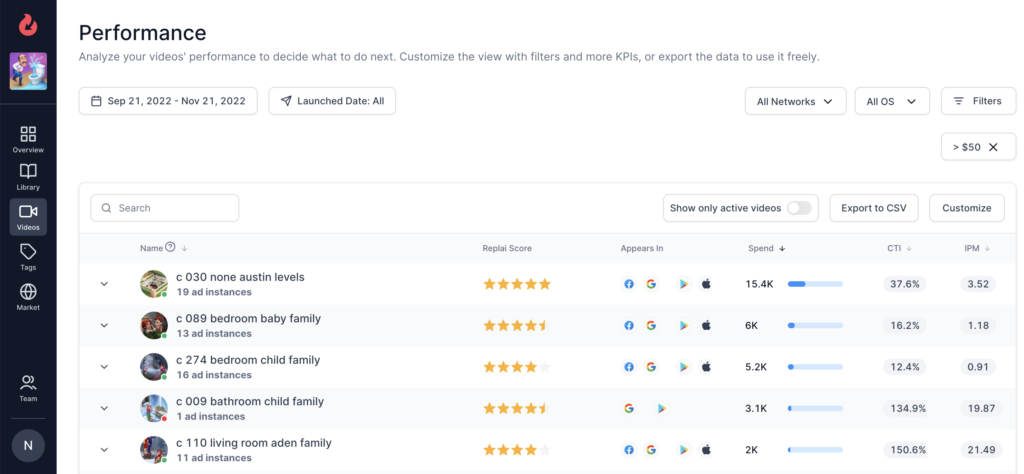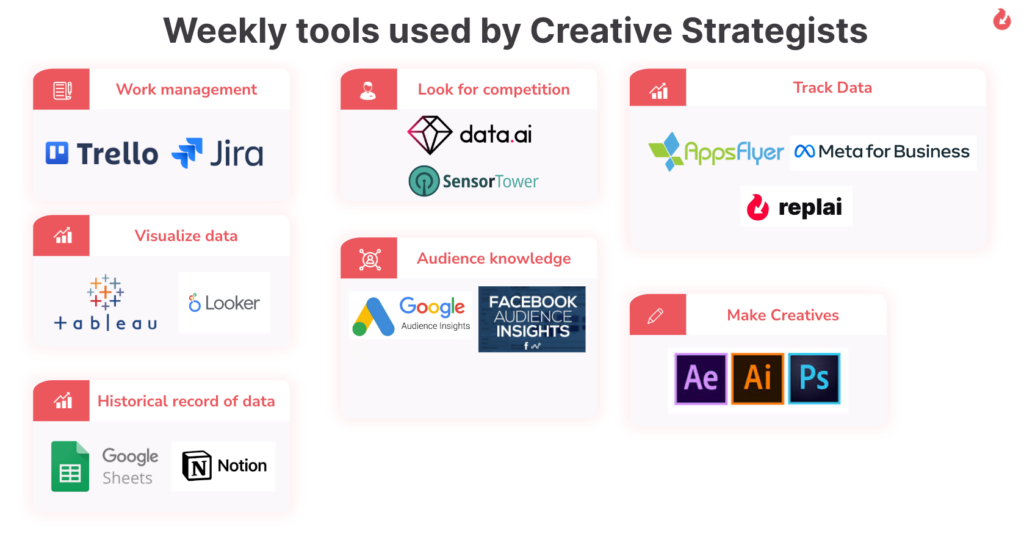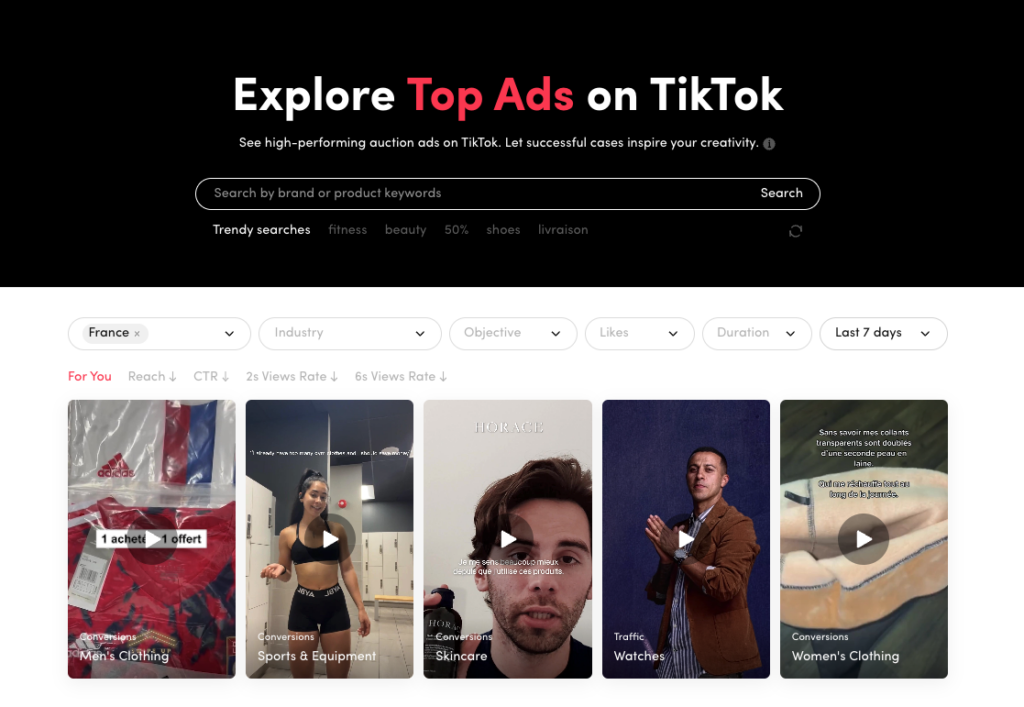Creative strategists are the backbone of the creative teams within mobile app companies. Responsible for developing data-driven creative strategies that help improve the performance of UA campaigns, their work is crucial to any successful mobile app company. This article dives into the DNA of a mobile creative strategist, the tools they need for success and the challenges they’re facing.
The profile of a creative strategist
The creative strategist is a unique individual with a multitude of skill sets. They’re adept at execution, collaborating cross-functionally with other members of the marketing team, such as art directors and user acquisition specialists, to ensure that the creative strategy aligns with the overall goals of the company.
They typically have a background in advertising, marketing or creative design and are responsible for developing creative strategies and experiments that will help improve the performance of paid campaigns.
This combination of creative and analytical skills comes together to help orchestrate successful paid ad campaigns.
Creative strategists are problem solvers and devise actionable creative ideas to fuel successful ad campaigns.
Creative strategist Selma Bambur describes a creative strategist as:
“that elusive character that sits between the creative, conceptual design phase and a more logical, robust strategic business phase. We add meaning and context to design to help create a business that blends the human emotional connection to your product/service with a more functional business goal.”
Please note the difference between Creative Specialists and Creative Strategists:
– Creative specialists are professionals who focus on execution, they are typically less analytical
– Creative strategists are generally more experienced and focus on devising the strategy themselves, adding a more analytical mindset.

A Typical Creative Strategist Job Description
This Creative Strategy Lead job description was published by the mobile app game company Zynga:
“The individual who fills this role would be responsible for delivering creative strategy and understanding creative performance as well as researching and analyzing industry creative trends.
The ideal candidate is highly analytical yet creative, can work independently, manage multiple projects/initiatives concurrently, as well as engage and collaborate with other teams & team members from across multiple disciplines and functions: Creative Strategy Director, Product Marketing Management, Game Development (producers/product managers), User Acquisition, ASO and Art Leads.”
Responsibilities:
- Deliver matrix creative strategy based on creatives performance and metrics
- Coming up with new, fresh creative approach, experiments and in parallel strongly focusing on creative optimizations
- Drive creative testing backed up with hypothesis in order to gain insights, identify opportunities and apply them in creative strategy
- Ongoing creative performance monitor, creative trends on the market, tight collaboration with Creative Conversion Analyst
- Day to day work with Art Lead to execute on the creative strategy, review concepts and ads
- Collaborate closely with UA & ASO to ensure creative strategy is on par with UA & ASO plans and tactics to maximize share of voice and channel mix
- Partner with product marketing managers to ensure that product features will be reflected in creative strategy
- Vendor selection and relationship maintaining
The psychological traits of a creative strategist
- Artistic and adaptable
- Discovery and ideation driven
- Team and user-oriented
- Enjoys creative freedom
- Prefers to experiment with new ideas, than rely on what’s been done before
- Aware of competitors and market trends
- Data-driven
- Curious

The work rhythm of a creative strategist
It is not uncommon for mobile app publishers to have over 1000+ creatives to manage for each of their apps.
Many mobile app companies generate anything from 20 to 100+ ad creatives per week – that’s a sheer volume of creatives required each week! Creative strategists need to understand the performance of existing campaigns to devise new ideas.
Tracking the best and worst performing aspects of previous campaigns is key to scaling success.
A typical week in the life of a creative strategist
Replai interviewed creative strategists among our customers to understand how they work. This is what we found a typical week as a Creative Strategist looks like:

- Ideation session
They begin the week with an ideation session, devising and brainstorming new ideas. The goal here is to develop as many new ideas for creatives as possible.
- Project management of creative production
Throughout the week, they manage the creative production process and deadlines, which requires close communication with the agencies responsible for the production and project-managing the production process, meeting deadlines and advancing tasks.
- Presentations for internal communications
Creative strategists will often create presentations to share with other teams, like marketing, product or executive teams, to explain what creative choices they made, why, and how previously made creatives are performing on paid channels. The goal is to keep the rest of the company informed about the performance of creatives and get feedback to orient the overall creative strategy.
- Campaign Analysis
Creative strategists regularly analyze active and historical creatives, tracking overall performance on paid channels. To do so, they often use manual processes with tools like Google Sheets to consolidate all the data per creative – they can also use more automated solutions like Replai. After producing the creatives of the week, they work with UA teams to build tests and experiments on paid channels, for example, on Facebook via their “Experiment” product feature.
- Creative Testing
Creative testing is critical for strategists because it will validate (or invalidate) their creative concepts. Their overall performance in their role is judged primarily on their creative win rate, which translates as their ability to produce creatives that pass the creative testing stage on ad networks (e.g. Facebook, Tiktok, Snapchat). As part of this process, they will partner with paid demand gen teams or User Acquisition teams, to build scientific A/B tests on ad channels. Then, monitoring creative performance punctuates every aspect of their work.
What is Creative Win Rate? A creative win rate refers to the percentage of creatives who have successfully passed the creative testing stage (experiment criteria are set by the app publisher). Creatives who didn’t pass the creative testing stage are “killed”, while those succeeding are leveraged further in ad campaigns to get more ad spend.

- Market Research
To get inspired by new ideas, creative strategists spend a great deal of time looking for trends in the mobile ads industry. From seeking ideas from competitors to identifying trending ads and even looking at other sectors or verticals, creative strategists actively seek new ideas to experiment with and monitor.
The challenges of a mobile app creative strategist
- Inspiration exhaustion.
Creative strategists are required to consistently devise new ad concepts.
Every week, they need to find or create new ideas, so they head to multiple sources of inspiration, including the internet, competitors, and mobile agencies.
As a result, creative strategists risk running out of creative energy, new ideas and inspiration.
- Constant juggling
Simultaneously managing multiple projects is a typical requirement for the job of creative strategist.
As well as being analytical and creative, incredibly sharp organizational skills are a must.
When they‘re in charge of a vast number of creatives, they need to coordinate creative ideation, creative iteration and production work across different agencies and teams.
- Internal comms
Creative strategists can lead a mobile app to success if they make the right creative choices that will make a campaign go viral.
However, their work also relies on the support of other teams. Hence, creative strategists need to excel at communicating with all levels of the company’s hierarchy, from C-suite to the marketing and strategy teams.
They must balance the creative side of their role with a very logical and analytical approach to communicating their strategies in the context of the wider business.
- Data monitoring maze
When you have 1000+ creatives per app or game, spread across 10+ ad networks – plus you’re launching 100 creatives a week, keeping track of all the data generated by these creatives becomes a real challenge.
Other team members also expect from creative strategists to share detailed insights, with interpretations of the performance data.
For example, why is creative A performing well on Snapchat but not on Tiktok? Or, why is putting more real-life footage on creatives in Japan bring in more installs?
- Wrong tools for the right job
A Creative strategist’s role requires sophisticated analysis of the performance of their creatives.
To perform these analyses, they often rely on internal resources and frequently ask their UA teams for data, which can often lead to frustration for everyone.
That’s why Replai was designed to give creative strategists a more direct access to their creatives’ performance.

- An overwhelming volume of creatives to launch
Producing and launching a high number of creatives every week can lead to creative exhaustion. It also requires high interpersonal and organizational skills to ensure the successful execution of tests and campaigns.
Once again, creative strategists need top organizational skills when they have to liaise with the agencies (or sometimes in-house colleagues) creating the creatives and the UA teams building the tests for these creatives on paid channels.
- Defending their position against creative choices remarks
Very often, executives will challenge creative strategists on specific ideas based on recent competitor activity. For example, “why does competitor A use beauty influencers and we don’t?”.
Creative strategists are expected to be omniscient and have a holistic view of creatives trending in their own category and the wider industry.
Given the volume of work already involved, technology for creative research is crucial for a busy and time-constrained creative strategist.
What tools do mobile creative strategists use in their work?

- Work management tools
Tools to manage the different creative projects, collaborate and communicate with teams (to-do deadline). Examples:
- Trello: a visual tool that empowers your team to manage projects, workflows, or tasks. Sync with internal or external teams in one real-time hub.
- Jira: originally designed as a bug and issue tracker, Jira has evolved into a powerful work management tool for all use cases, that Creative Strategists can leverage.
- Monday.com: a platform for project management and asynchronous collaboration.
- Asana: a work management platform designed to help teams organize, track, and manage their work.
2. Competitor benchmarking tools
Ad creative benchmarking tools are numerous for digital. Examples include:
- SEMRush – for ad banners benchmarking, keyword research and online ranking data
- Similarweb – for web analytics and similar ad creative benchmarking
- Facebook ad library – for a comprehensive, searchable collection of all ads currently running from across Meta
In the mobile space, the leading data analytics platforms are also used to deep dive into the ad creative markets:
- Data.ai – an AI platform bringing together consumer data and market estimates, collecting data about creatives from all mobile app publishers
- SensorTower – Market intelligence and performance metrics for mobile apps, they also provide insights on mobile ad creatives.
- MobileAction – MobileAction is an intuitive mobile app intelligence platform with a mobile ad creative library.
3. Performance data tracking tools
With these tools, creative strategists can source data about the performance of their creatives on paid channels. Data is aggregated and the relevant metrics are shown for creatives (e.g. ROASD7, Retention rate, etc.). Examples include:
- Appsflyer – AppsFlyer is a mobile marketing analytics and attribution platform that provides access to insightful data for your app marketing campaigns in real-time
- Adjust – Adjust is an analytics and measurement platform helping marketers optimize campaigns.
- Singular – Singular unifies marketing data to provide intelligent insights
- Kochava – A unified platform that enables creative strategists to measure and optimize marketing campaigns
- Tenjin -Advertising measurement tool consolidating marketing data
- Replai – A creative intelligence platform, Replai aggregates and consolidates performance data on the creative level to help creative strategists carry out more in-depth analysis, faster.
4. Data visualization tools
These tools consolidate all the data on a company level across different branches (product data, revenue data, etc). Often, data about creatives is channeled to these tools to allow for more in-built charts and visualizations.
- Tableau – a business intelligence and data visualization tool
- Looker – a platform for BI and embedded analytics
5. Tools to build knowledge about the audience
Ad channels generally provide valuable insights about the audience they can target. Therefore, Creative strategists look into these tools to better understand the users they want to target. Examples include:
- Google Audience Insights – designed to help you find new audiences by showing valuable information about your website visitors and app users.
- Facebook Audience Insights – designed to provide you with aggregated information about two groups of people – people connected to your Page and people on Facebook – so you can create content that resonates and readily find more people like the ones in your current audience.
6. Video and Creative Production Tools
There are many tools available to build mobile app creatives. Tools from the Adobe Creative Suite are the most popular among our interviewed creative strategists:
- Adobe After Effect
- Photoshop
- Adobe Illustrator
7. Creative brainstorming tools
Creative strategists use tools to develop new ideas and perform practical brainstorming sessions. Examples include:
- Milanote
- Replai
The creative strategist’s essential skills: what do they need to know?
For a creative strategist working in the mobile app industry, they first need an understanding of the mobile ads ecosystem, including:
– knowledge about the different ad networks and their differences (e.g. Tiktok, Snapchat, Unity, Facebook, etc.)
– how to launch ad campaigns on these networks (A/B testing and experiments, campaign types, etc.)
– the top metrics that drive UA leaders’ decisions (ROASD7, CPPD7, CPI, IPM, CTI, etc.).
Creative strategists need to carefully consider ad specifications, including:
- Ad type (video, playable ads, etc.)
- Ad format (e.g. for a video: aspect ratio, duration, etc.).
They need to be aware of the different target audience filters that can be leveraged in ad campaigns (as these filters can influence creative engagement), such as:
- behavioral filters (e.g. app retargeting)
- demographic filters (age, gender, location)
- psychographic data (e.g. interests, likes, etc).
Besides, Creative strategists need to build strong expertise in how to build clear and compelling creative briefs, and how to evaluate and measure the performance of an ad creative.
To set themselves apart, creative strategists need to commit to professional growth and continued learning. For example, the Meta Certified Creative Strategy Professionals is a newly launched certification for creative strategists.


